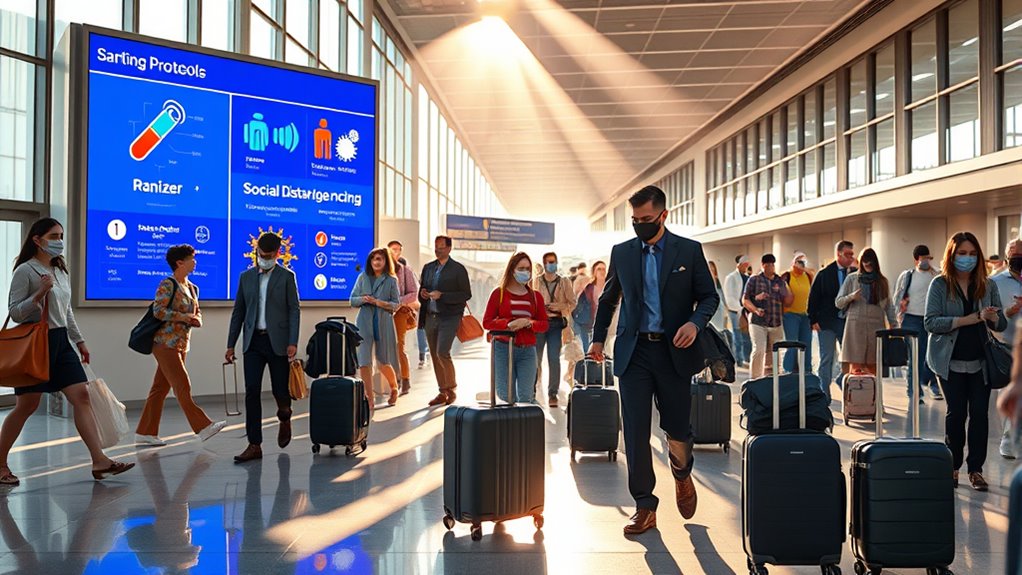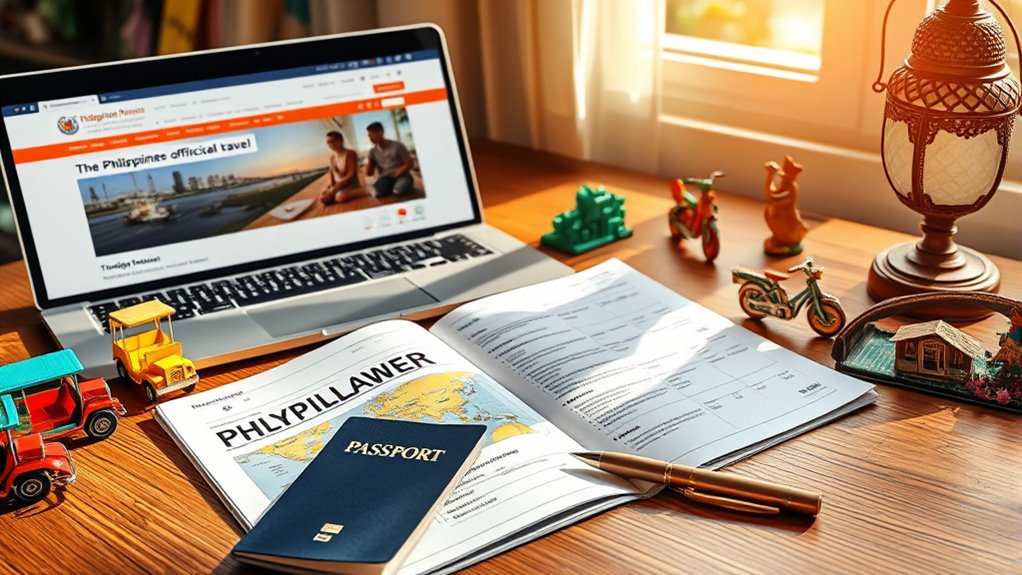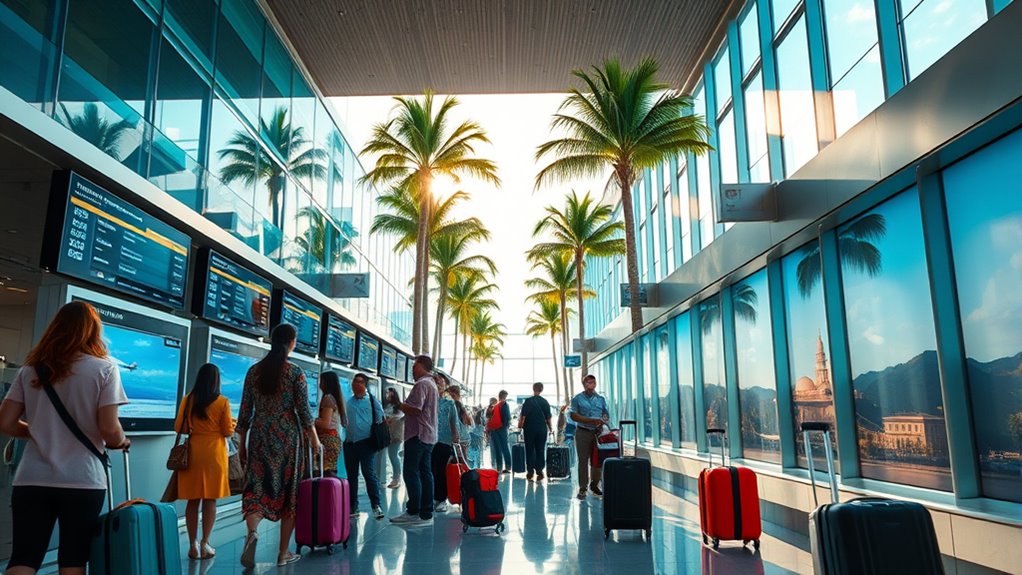When traveling to the Philippines, make sure your passport is valid for at least six months beyond your stay. Many nationalities can enter visa-free for up to 30 days, while e-visa options exist for others. Don’t forget to register on the eTravel Portal before arrival, and check health protocols, especially regarding COVID-19. Respect local customs and be prepared for warm hospitality. There’s much more to explore about travel planning and local tips.
Key Takeaways
- Ensure your passport is valid for at least six months beyond your intended stay in the Philippines.
- Nationals from eligible countries can enter visa-free for up to thirty days; verify your country’s status.
- Complete registration on the eTravel Portal within 72 hours prior to arrival for entry clearance.
- Fully vaccinated travelers are exempt from quarantine, but a negative COVID-19 test is required if no booster shot has been received.
- Familiarize yourself with local customs and cultural etiquette to enhance your travel experience in the Philippines.
Passport Validity and Requirements

When planning your trip to the Philippines, it’s important to verify your passport is valid for at least six months beyond your intended stay. This requirement applies to most travelers, guaranteeing you won’t face issues upon entry.
Check that your passport won’t expire during your visit, as that can lead to complications. While some countries may have different rules, sticking to the six-month standard is safest. If your passport is nearing expiration, renew it well ahead of your travel date to avoid delays.
Visa-Free Entry and Evisa Options

If you’re traveling from an eligible country, you can enjoy visa-free entry into the Philippines for up to thirty days. Nationals from countries like Andorra, Australia, Chile, and France can take advantage of this privilege.
Just make sure your passport is valid for at least six months beyond your stay and that you have a return or onward ticket. If you need to stay longer, you can apply for an extension at the Bureau of Immigration.
Ensure your passport is valid for six months beyond your stay and have a return ticket for smooth travel.
Additionally, if you’re not from a visa-free country, the Philippines offers e-visa options for specific travelers, allowing you to apply online.
Remember to check eligibility and submit your application in advance to make your travel as smooth as possible!
Registration and Etravel Documentation

Before you arrive in the Philippines, you’ll need to complete registration on the eTravel Portal, a mandatory platform for all passengers. You can register up to 72 hours before your arrival at https://etravel.gov.ph.
This free service replaces the old One Health Pass and simplifies entry by minimizing paperwork. To register, make certain you have a valid passport with at least six months of validity, along with accurate travel details.
A return or onward ticket may be required, and proof of accommodation could be requested. Keep in mind that foreign diplomats and certain special visa holders are exempt from this registration.
Always use the official site to avoid scams and verify your information is correct.
Health and Safety Protocols

As you prepare for your trip to the Philippines, it’s vital to familiarize yourself with the health and safety protocols in place.
Familiarize yourself with health and safety protocols before traveling to the Philippines for a smooth journey.
You won’t need to present vaccination certificates for COVID-19, but if you haven’t received a booster shot, you must show a negative RT-PCR test taken within 48 hours or an antigen test within 24 hours before departure.
Fully vaccinated travelers don’t have to quarantine but should self-monitor for symptoms for seven days.
It’s a good idea to have travel insurance covering COVID-19 treatment and keep your health declaration updated.
Be aware of local health alerts, and check recommendations from the CDC.
Finally, verify your vaccinations are up to date to protect your health during your stay.
Travel Planning Considerations

When planning your trip to the Philippines, it’s essential to contemplate various factors that can enhance your experience.
First, consider visiting during the dry season from December to February for cooler temperatures and less rain. Peak tourist times, especially around Christmas and New Year, can lead to crowded attractions.
Most travelers enjoy visa-free entry for up to 30 days, allowing for a relaxed stay. Make certain to invest in travel insurance for peace of mind, even though it isn’t mandatory.
Keep in mind that inter-island travel can be time-consuming, so plan your logistics and transport accordingly.
Finally, be aware of potential weather-related delays, especially during the wet season, to guarantee a smooth journey.
Additional Travel Documentation

Traveling to the Philippines requires you to be aware of several key documentation needs, ensuring a smooth entry into the country. Your passport must be valid for at least six months beyond your intended stay, so check that it won’t expire soon.
You’ll also need to register on the eTravel portal within 72 hours of your arrival, which is free and helps with health surveillance. Proof of onward or return travel is often required, so keep your tickets handy.
If you’re from a visa-exempt country, you can stay for up to 30 days without a visa, but confirm your eligibility. While travel insurance isn’t mandatory, it’s highly recommended to cover unexpected expenses during your trip.
Understanding Business Visa Requirements

What do you need to know about securing a business visa for the Philippines? A business visa lets you enter the country for temporary business activities like meetings and conferences.
It’s a non-immigrant visa, meaning you can’t seek long-term employment. To apply, you’ll need a valid passport, a completed application form, and proof of financial capability, such as bank statements.
An invitation letter from a local business partner can also be helpful. You can submit your application in person or online, depending on your nationality. Processing usually takes about 15 working days.
Safety Tips for Travelers

Ensuring your safety while exploring the Philippines requires a proactive approach to your surroundings. Always stay vigilant about your personal belongings, especially in crowded areas where petty theft is common.
Travel insurance is a must, as it protects you against theft, medical emergencies, and trip cancellations. Familiarize yourself with local emergency contact numbers and laws for quick responses if needed.
When getting around, use licensed taxis or ride-sharing apps like Grab, and avoid unmarked vehicles. Keep valuables hidden and use anti-theft bags.
Stay cautious on public transport, especially in larger cities. Finally, stay hydrated, know the nearest hospitals, and register with your embassy for added support during your stay.
Cultural Awareness and Local Customs

Understanding the cultural nuances and local customs of the Philippines enhances your travel experience and fosters meaningful interactions with the locals.
Filipinos deeply respect their elders, so using titles like “po” and “opo” shows your appreciation. You’ll notice that verbal etiquette, like addressing older individuals as “ate” or “kuya,” is common and appreciated.
Embrace the pasalubong tradition by bringing gifts for your hosts; it symbolizes thoughtfulness. Family and community are central to Filipino life, so prioritize harmony in conversations.
Expect warm hospitality, as locals are enthusiastic to welcome visitors. Finally, remember that sharing and giving are essential to social bonding, so participate in this cultural practice to connect more with the people around you.
Frequently Asked Questions
What Should I Do if My Passport Is Lost During Travel?
If your passport’s lost during travel, first, file a police report at the nearest station.
Next, notify your embassy or consulate to get guidance on replacing it. You’ll need to secure a notarized affidavit of loss and gather all necessary identification documents.
Follow the embassy’s instructions carefully for obtaining a replacement or emergency travel document.
Keep copies of your documents handy to avoid delays in the process.
Are There Any Restrictions on Bringing in Foreign Currency?
Yes, there are restrictions on bringing in foreign currency.
You can bring any amount without declaring it, but if you have over USD 10,000, you must declare it to customs.
Additionally, cash amounts over PHP 50,000 require prior written authorization from the Bangko Sentral ng Pilipinas.
To avoid issues, always declare your currency accurately and complete the necessary forms, as failing to do so may result in penalties or confiscation.
Can I Extend My Stay Beyond 30 Days?
Yes, you can extend your stay beyond 30 days.
To do this, you’ll need to apply at the Philippine Immigration Bureau at least 7 days before your initial visa expires.
You can typically extend your stay for up to 29 days initially, and after that, you can apply for longer extensions.
Just make sure you have the necessary documents, such as your valid passport and completed application form, ready for submission.
What Are the Local Emergency Numbers in the Philippines?
In the Philippines, knowing the local emergency numbers is like having a lifeline during unexpected storms.
You’ve got a range of numbers to call when trouble strikes. For police assistance, dial 117. For fire emergencies, reach the Bureau of Fire Protection at (02) 8426-0219.
Need medical help? Contact the Philippine Red Cross at 143.
And when disaster strikes, the National Disaster Risk Reduction and Management Council (NDRRMC) can be reached at (02) 8911-5061.
Is It Safe to Travel to Remote Islands?
Traveling to remote islands in the Philippines can be safe, but you should stay vigilant. While violent crime is rare, petty theft can occur, so secure your valuables.
Be aware of your surroundings and avoid unfamiliar areas at night. Natural hazards like typhoons may pose risks, so monitor weather conditions.
Remote islands offer a unique experience, but it’s important to plan for emergencies and respect local customs to guarantee your safety.
Conclusion
Steering through the Philippine travel requirements might seem like a formidable maze, but don’t worry—it’s easier than finding a needle in a haystack! By ensuring your passport is valid, understanding visa options, and keeping up with health protocols, you’ll be ready for an unforgettable adventure. Just remember to embrace the local customs and stay safe while immersing yourself in the vibrant culture. With a little preparation, you’re all set for a trip of a lifetime!









